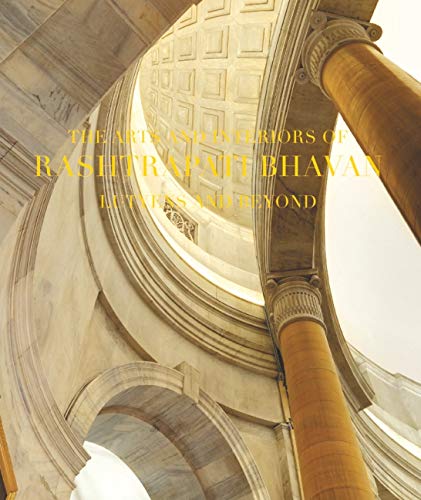partha mitter naman ahuja (2 resultados)
Tipo de artículo
- Todo tipo de artículos
- Libros (2)
- Revistas y publicaciones
- Cómics
- Partituras
- Arte, grabados y pósters
- Fotografías
- Mapas
-
Manuscritos y
coleccionismo de papel
Condición
- Todo
- Nuevos
- Antiguos o usados
Encuadernación
- Todo
- Tapa dura
- Tapa blanda
Más atributos
- Primera edición (1)
- Firmado
- Sobrecubierta
- Con imágenes del vendedor
- Sin impresión bajo demanda
Ubicación del vendedor
Valoración de los vendedores
-
The Arts and Interiors of Rashtrapati Bhavan: Lutyens and Beyond
Publicado por Publications Division, 2016
ISBN 10: 8123021305ISBN 13: 9788123021300
Librería: Books in my Basket, New Delhi, India
Libro
Hardcover. Condición: New. 335pp.This Volume brings together the scholarly attention of different specialists on the history of art, visual culture, furniture, carpets and textiles, and paintings of the Rashtrapati Bhavan. Their chapters provide an illuminating political and cultural history of the interior designed by sir Edwin Lutyens to be the house for the British viceroy. The book also provides a detailed catalogue of select artwork kept in the house . Rich illustrations reveal how the interiors stand now, and they are contrasted with archival Photographs that show how the house has evolved over the past 90 years. The Book also contains previously unpublished plans and sketches for the decor of the interiors of the house some of which date back to as early as 1914-these provide a rare glimpse into how it was originally intended.While the architecture of the actual edifice of the Rashtrapati Bhavan may be Lutyens?s most enduring legacy, the interiors of the building preserve a much more versatile history. This Volume traces how Lutyens achieved a stylish interior that accommodated the tastes and needs if various British aristocratic residents, politicians and bureaucrats, but equally had to impress an Indian public-for which, it needed also to incorporate a vocabulary of Indian design ornament.This volume is one in a series that documents different aspects of the rich cultural , social and historical legacy of the Rashtrapati Bhavan as a national institution.
-
The Arts and Interiors of Rashtrapati Bhavan: Lutyens and Beyond
Publicado por Publications Division, 2016
ISBN 10: 8123021305ISBN 13: 9788123021300
Librería: Vedams eBooks (P) Ltd, New Delhi, India
Libro Original o primera edición
Hardcover. Condición: New. 1st Edition. Contents: Preface. Introduction. 1. The Battle of Styles in New Delhi: the political background/Partha Mitter. 2. Studying lutyens and his context/Naman P. Ahuja. I. Design Vocabulary. 3. Design a public inner world. 4. A catalogue of Artefacts/Naman P. Ahuja. II. Murals. 5. The politics of architectural decoration/Partha Mitter. III. Painting and Sculpture. 6. Painting colonial and modern at the Rashtrapati Bhavan. 7. A catalogue of select artworks/Rebecca Brown. IV. Furniture. 8. Thrones, armoires, benches and more: eclectic appointments for a modern stately home. 9. A catalogue of select furniture/Laura Ongaro. V. Textiles. 10. From the flag above the dome to carpets beneath their feet. 11. A catalogue of select textiles/Monisha Ahmed. Bibliography. Index. This volume brings together the scholarly attention of different specialists on the history of art, visual culture, furniture, carpets and textiles, and paintings of the Rashtrapati Bhavan. Their chapters provide an illuminating political and cultural history of the interior design of India's presidential residence which was originally designed by Sir Edwin Lutyens to be the house for the British viceroy. The book also provides a detailed catalogue of select artworks kept in the house. Rich illustrations reveal how the interiors stand now, and they are contrasted with archival photographs that show how the house has evolved over the past 90 years. The book also contains previously unpublished plans and sketches for the decor of the interiors of the house some of which date back to as early as 1914- these provide a rare glimpse into how it was originally intended. While the architecture of the actual edifice of the Rashtrapati Bhavan may be Lutyens's most enduring legacy, the interiors of the building preserve a much more versatile history. This volume traces how Lutyens achieved a stylish interior that accommodated the tastes and needs of various British aristocratic residents, politicians and bureaucrats, but equally had to impress an Indian public-for which, it needed also to incorporate a vocabulary of Indian design ornament. After the independence of India, many symbols of the colonial empire were rendered inappropriate and the interiors of the Rashtrapati Bhavan had to be transformed into the home of the president of a democratic republic with a rich history. This glimpse into the tastes of its different residents and the compulsions that guided them traces a most telling history of a changing world. This volume is one in a series that documents different aspects of the rich cultural, social and historical legacy of the Rashtrapati Bhavan as a national institution.


